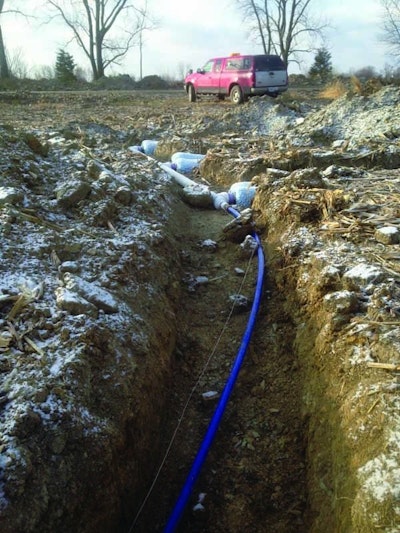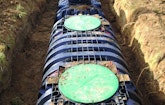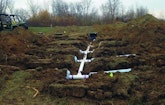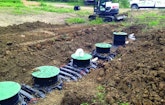
Interested in Alarms/Controls?
Get Alarms/Controls articles, news and videos right in your inbox! Sign up now.
Alarms/Controls + Get AlertsAs if the number of systems wasn’t enough, there were the mixed-up soils. Together, those two factors added up to a challenge, but one that New Excavating Technology Inc. of St. Anne, Illinois, was prepared to handle.
Start with the size of the project. Giant Goose Ranch covers 828 acres in Canton, Illinois, about 150 miles southwest of Chicago and not too far from Peoria. In the 1930s and 1940s the land was a strip mine. After the coal was extracted, the 60- to 80-foot-deep pits were left to fill with water and become a network of small lakes that squiggle all over this part of Illinois. In 1954 the property was reclaimed and developed into a campground. In 2013 the present owners purchased the property and began rehabilitating it.
This is where Ray Tebo entered the picture. The owner of New Excavating Technology was asked to design a wastewater solution for the campground and recreational complex that would ultimately house hundreds of people and include swimming beaches with bathhouses, and a banquet facility.
Initial work
Tebo saw only two possible solutions: an NPDES permit for discharge to surface waters, or a membrane bioreactor (MBR) system to put recycled water into the soil. Because the soils were so variable, he had an engineer test them. “I have 90 pages of soil reports. Go 10 feet one way and the soils were good. Go 10 feet the other way and they were bad.” Infiltrometer tests showed that the worst absorption rate was about 1/4 inch of water per hour (KSAT value). This is not suitable for normal septic systems, according to state code.
The topography was another impediment. “Everywhere you turn there are lakes. Everywhere you turn there’s elevation. I would say the bigger challenge was elevation, because with MBRs we can put the field right up to the water. You drive up and down 30, 40, 50 feet all over out there. Fulton County is like that. A large portion is lakes and hunting property.”
Campgrounds at Giant Goose Ranch follow the wandering borders of the lakes. Each campsite is a bed of crushed stone that can hold an RV or a cabin built to the customer’s specifications and mounted on skids, and each site has a standpipe to accept wastewater.
The surface discharge option failed because U.S. Environmental Protection Agency regulations won’t allow it if water can be infiltrated somehow, Tebo says. And he figured out how. With the soils so variable, a membrane bioreactor was the best solution but Tebo knew it would not be economically feasible to have one MBR per site. He talked to the owners about combining flows from several sites and leading their wastewater to a local treatment system. In total, this initial phase of the project required 17 separate systems. The owners agreed.
Uniform systems
Each campsite has a 4-inch standpipe, and the pipes from a cluster of sites lead into a 4-inch main. The mains flow to a 1,000-gallon tank from Infiltrator Water Technologies. This not only collects trash but also functions as a septic tank for primary treatment. From the trash tank, wastewater flows by gravity through a Bio-Microbics SaniTEE and into a 1,500-gallon Infiltrator Water Technologies tank fitted with two 500 gpd BioBarrier MBRs (Bio-Microbics). Recycled water flows only a short distance to the absorption fields, usually about 10 feet. “With recycled water you don’t look for the best soil. You look for where you can put it close to the units,” Tebo says. This saves on materials and labor.
A pair of custom-made stainless steel marine pumps from Bio-Microbics draw water out of the MBR at a rate of about 1/2 gallon per minute. This water is sent through a 2-inch pipe that transitions to the 4-inch Schedule 40 pipe that feeds 300 feet of EZflow by Infiltrator laterals. The MBRs are controlled by a panel from Bio-Microbics. Information comes to the panel from transducers instead of floats.
Because of the elevation changes, Tebo had to install lift stations at some points to feed wastewater to the trash tanks or recycled water to the EZflow fields. Duplex pumps from Champion Pump Company and duplex control panels from Aquaworx by Infiltrator are used where lift stations are needed. He built all the stations in the same way to make field repairs or replacements easy.
He started with a 540-gallon Infiltrator Water Technologies tank. Each tank has either a trash grinder pump if it handles wastewater from sites or a standard pump if it handles recycled water from an MBR. All the lift stations and MBR assemblies were built in Tebo’s shop using heavy-duty pressure fittings and stainless steel components for easy parts replacement. When each unit was finished, a worker vacuumed it completely to remove any shavings.
Two-inch pipe comes out of the pumps and moves the water as far as necessary, 300 to 400 feet in some cases. All the pipes are buried below the frost line and accompanied by tracer wires.
Tebo’s shop is set up so every piece is cut on stands, and all the pieces are laid out and categorized on benches. All parts are cut to length with guides and de-burred for precision. This makes repairs simple because workers make spares, label all parts and place them in cabinets.
Continuous adjustment
A nice feature of the Aquaworx and Bio-Microbics panels is that all data in them can be downloaded onto a USB drive, Tebo says. “I can tell you when people have a party, and this knowledge allows me to reprogram the panel to more closely match how the system will be used.” Every three months he will look at data from all the MBRs and adjust them accordingly.
For this installation, MBRs are perfect because there are a variety of sources feeding wastewater at different rates. For initial startup, mixed liquor was hauled from a nearby wastewater treatment plant to seed the MBRs with the necessary microbes. For winter, the systems are shutdown but the airflow is left on to keep the microbes alive and active. In the spring, each MBR will be reseeded with more mixed liquor.
There is more development to come and more work, but Tebo knows only part of it. Each beach bathhouse will have a 1,000 gpd system like those for the campsites. There will be a store building, but he doesn’t know yet how large that will be so he hasn’t designed that system. He has designed the system for the 200-person banquet hall. That will be a 3,000 gpd system consisting of a large tank with several manholes, each capable of holding an MBR unit. Not all the slots will be filled at first, and this will save his customers money because it will lower their initial cost. If more capacity is needed later, Tebo will drop another MBR into the tank.
When the project began, there was about a year of preliminary work and education. Because the BioBarrier falls under the NSF 350 water rules, it was outside the State of Illinois septic code. Tebo had to obtain permits from state and local health authorities, and as part of the process he participated in workshops with local health officials and representatives from Bio-Microbics who explained their technology. Once they had that information, public health officials were on board with the project, Tebo says.
With advanced treatment technology at his disposal, Tebo helped turn an old eyesore into a modern and clean recreational destination.










